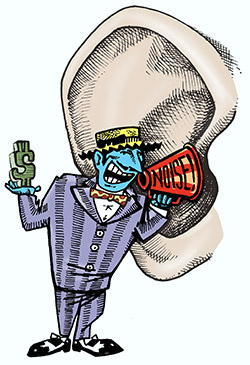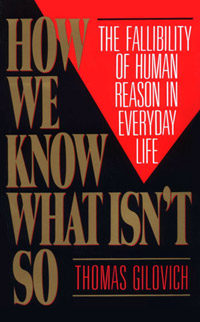In this week’s eSkeptic, Ethan Winer (an audio engineer, musician, and skeptic), reveals that the worlds of audio engineering and consumer electronics are filled with pseudoscience.

Audiophoolery
by Ethan Winer
YOU MIGHT THINK that a science-based field like audio engineering would be immune to the kind of magical thinking we see in other fields. Unfortunately, you would be wrong. In my 35 years as a professional audio engineer and musician, I’ve seen some of the most outrageous pseudoscience sold to consumers, and even to other audio pros who should know better. Not unlike claims for alternative medicine, nonsense is shrouded in scientific-sounding jargon to confuse the uneducated, or a sales pitch will cite science that is legitimate but irrelevant. The result is endless arguments among audiophiles over basic scientific principles that have been fully understood for fifty years or more.
As a consumerist, it galls me to see people pay thousands of dollars for fancy-looking wire that’s no better than the heavy lamp cord they can buy at any hardware store. Or magic isolation pads and little discs made from exotic hardwood that purport to “improve clarity and reduce listening fatigue,” among other surprising claims. The number of scams based on ignorance of basic audio science grows every day. Surely some of these vendors know they’re selling snake oil, but I’m certain that just as many believe their own hype. I’d respect these people more if I thought they knew they were conning people!
Few of us have unlimited budgets and must spend what funds we have wisely. Therefore, the purpose of this article is to help consumers distinguish truth from fiction in order to determine what is and is not worthwhile. Experience has shown that it’s futile to claim I know what someone else can or cannot hear. Therefore, I will relate only those things that matter to my experienced ears, and explain what makes sense from the perspective of science and logic. You don’t need an engineering degree to understand the explanations that follow, though I’ll assume you’ve played with a stereo receiver and CD player or cassette deck a few times. I’ll begin by defining the four basic audio parameters so that when I describe some common audiophile scams you’ll understand why they are scams.
Audio Parameters Defined
Only four parameters are needed to define everything that matters for audio reproduction: Noise, frequency response, distortion, and timebased errors. Let’s look at each of these in turn.
1. Noise is the background hiss you hear when you turn your receiver way up, and you can also hear it during quiet passages when playing open reel or cassette tapes. A close cousin is dynamic range, which defines the span (expressed in decibels) between the background noise and the loudest level possible before the onset of gross distortion. CDs and DVDs have a very large dynamic range, so any noise you may hear was either from the original analog tape, was added as a byproduct during production, or was present in the room and picked up by the microphones when the recording was first made.
Subsets of noise are AC power-related hum and buzz, electronic crackling, vinyl record clicks and pops, between-station radio noises, tape modulation noise, and the triboelectric cable effect. You’re unlikely to notice tape modulation noise outside of a recording studio because it’s specific to analog tape recorders, which are fast becoming obsolete, and it is usually hidden by the music itself. You can sometimes hear it if you listen carefully to a recording of a bass solo, where each note is accompanied by a “pfft” sound that disappears between the notes. The triboelectric effect is also called “handling noise” because it occurs when handling poorly made cables. I haven’t seen a cable with this defect in about 20 years.
2. Frequency response is how uniformly a device responds over a range of frequencies. Errors are heard as too much or too little bass, midrange, or treble. For most people, the audible range extends from about 25 Hz at the low end, to just shy of 20 KHz at the high end. Even though many audiophiles believe it’s important for audio equipment to respond to frequencies far beyond 20 KHz, in truth there is no need to reproduce ultrasonic content because nobody can hear it. Subsets of frequency response are physical microphonics, electronic ringing and oscillation, and acoustic ringing. These subsets are not necessary for consumers to understand, but they are important to design engineers and acousticians.
3. Distortion is the common word for the more technical term nonlinearity, and it adds new frequency components that were not present in the original source. When music passes through a device that adds distortion, new frequencies are created that may or may not be pleasing to the ear. The design goal for audio equipment is that all distortion be so low in level that it can’t be heard. I’ll return later to the notion that distortion can be pleasing when I explain why some audiophiles prefer vinyl records and tube-based electronics.
There are two basic types of distortion—harmonic and intermodulation—and both are almost always present together. Harmonic distortion adds new frequencies that are musically related to the source. In layman terms, harmonic distortion adds a slightly thick or buzzy quality to music. All musical instruments create tones having harmonics, so a device whose distortion adds a little more merely changes the instrument’s character by some amount. Electric guitar players use harmonic distortion—often lots of it—to turn a guitar’s inherent plink-plink sound into a singing tone having great power and sustain.
Intermodulation (IM) distortion requires two or more frequencies to be present, and it’s far more damaging because it creates new content that is musically unrelated to the original. Even in relatively small amounts, intermodulation distortion adds a dissonant quality that is unpleasant to hear. Another type of distortion is called aliasing, and it’s unique to digital recording. Like IM distortion, aliasing creates new frequencies not harmonically related to the original, and so is unpleasant and irritating to hear. Fortunately, in all modern digital gear, aliasing is so low in level that it’s inaudible.
4. Time-based errors affect mainly pitch and tempo. If you’ve ever played an old LP record where the hole was not quite centered, you’ve heard the pitch rise and fall with each revolution. This is called wow. Analog tape recorders suffer from a different type of pitch instability called flutter. Unlike the slow pitch change of wow, flutter is more rapid, producing a warbling effect. Digital recorders have a unique type of timing deviation called jitter, but with all modern equipment, jitter is so much softer than the music that you’ll never hear it. The last type of time-based error is phase shift, but it’s benign even in relatively large amounts.
Room acoustics could be considered a fifth audio parameter, but it really isn’t. Nearby room boundaries can create frequency response errors (called comb filtering) due to wave reflections combining in the air. Reflections can also create audible echoes and reverb, but these are timebased phenomenon that occur outside the equipment, so they don’t warrant their own category either.
The above parameters encompass everything that affects audio fidelity. If a device has noise and distortion too low to hear, a response sufficient to capture the entire range of audible frequencies, and time-based errors small enough to be insignificant, then that device will be audibly transparent to music and other sound passing through it. However, clarity and stereo imaging are greatly affected by room acoustics; without question, the room you listen in has far more effect on sound quality than any of the audio components.
You may have noticed that several times I referred to errors that can be too soft to hear, like the inherent background noise of a CD, or are inaudible because they’re much softer than the music and are thus masked by the music. Masking is an important concept because it prevents us from hearing low-level artifacts in the presence of a source that is louder—especially if both contain similar frequencies. For example, low frequency hum caused by a bad connection is the same volume whether the music is playing or not. So when you stop the CD, you can more easily hear the hum. If the music consists of a cymbal or tambourine only, you’ll hear the hum even while the music plays because those instruments contain primarily high frequencies. But when drums or a bass play, those instruments will probably mask the hum. Some artifacts like tape modulation noise and jitter occur only while the music plays. So unless they’re fairly loud, they won’t be audible at all.
The Cable Guy
The earliest audio scam I can recall is fancy wire for connecting loudspeakers, and it’s still going strong. These days vendors claim their wire yields better sound quality when compared to normal wire, and, of course, it’s much more expensive than normal wire. In truth, the most important property of speaker wire is resistance, which is a function of its thickness. The resistance must be low to pass the high-current signals a power amplifier delivers. For short distances— say, up to five feet—16-gauge wire of any type is adequate, though thicker wire is needed for longer runs.
The three other wire parameters are inductance, capacitance, and skin effect. But those are not a factor with usual cable lengths at audio frequencies, especially when connecting speakers to a power amplifier. Low capacitance wire can be important in special cases, such as between a phonograph cartridge and its preamp. But high quality, low capacitance wire can be had for pennies per foot. Wire scams are very popular because wire is a low-tech device that’s simple to manufacture and the profit margin is extremely high. I could devote this entire article to wire scams, but instead I’ll just summarize that any audio (or video) cable costing more than a few dollars per foot is a rip-off.
Even sillier than expensive speaker wire is replacement AC power cords and most other power “conditioner” products. The sales claims sound logical: Noise and static can get into your gear through the power line and damage the sound. In severe cases it’s possible for powerrelated clicks and buzzes to get into your system, but those are easily noticed. The suggestion that subtle changes in “clarity and presence” can occur is plain fraud. Indeed, every competent circuit designer knows how to filter out power line noise, and such protection is routinely added to all commercial audio products. Spending hundreds of dollars on a six-foot replacement power cord ignores the other hundred-odd feet of regular wire between the wall outlet and power pole.
Some audio scams are so blatant you wonder how anyone could fall for them, like a replacement volume control knob that sells for $485. The ad copy proclaims, “The new knobs are custom made with beech wood and bronze … How can this make a difference??? Well, hearing is believing as we always say. The sound becomes much more open and free flowing with a nice improvement in resolution. Dynamics are better and overall naturalness is improved.” Yes, I bet that’s just what they always say. Wood is a common theme among audiophile scams, falsely implying a relation to a fine old violin where the wood’s vibration really is a part of the sound. But a volume control knob?

illustration by Joe Lee
Do You Hear What I Hear?
Among devoted audiophiles, one of the most hotly debated topics is the notion that ultrasonic frequencies are necessary for high fidelity reproduction. Put aside for a moment that no human can hear much past 20 KHz. Few microphones respond to frequencies beyond that, and even fewer loudspeakers can reproduce that high. If maintaining an extended frequency response were free, I’d have little objection. But in this digital age, storing frequencies higher than necessary waste memory, media space, and bandwidth. Even sillier is the way audio is handled on DVD soundtracks. DVDs accommodate frequencies up to 96 KHz, but then “lossy”data compression— which results in an audible loss in quality—is often needed to make it fit! Record companies and equipment manufacturers just love that millions of people replaced all their old LPs and cassettes with CDs. They’re trying very hard to get us to buy all the same titles, and new gear to play them, yet again with the false promise of fidelity that exceeds CDs.
Another popular scam is mechanical isolation devices. The claims have a remote basis in science that are skewed to suggest importance where none is justified. If you ever owned a turntable, you know how sensitive it can be to mechanical vibration. Unless you walk lightly, the record can skip, and if you turn up the volume too high, you’ll get a low frequency feedback. A turntable is a mechanical device that relies on physical contact between the needle and the record’s surface. CDs (and DVDs) work on an entirely different principle that is immune to mechanical vibration. As the CD spins, the digital data is read into a memory buffer, and from there it is sent to your receiver or headphones. Several seconds of music are always in the player’s buffer, so if the player is jostled enough that the CD mistracks, it simply sends from the buffer until the drive can find its place again. Large buffers are common on CD players meant for joggers for this exact reason.
Isolation has no advantage for other electronic gear either. You can spend thousands of dollars on fancy isolation devices for preamps and receivers, yet they don’t improve the sound even a tiny bit (though mechanical isolation with loudspeakers is valid). A related scam is cable elevators— small devices that prevent your wires from touching the floor. Like so many other audiophile “tweak” products, the claims for cable elevators sound magical, and they surely are.
Bi-wiring is a more recent scam, and it’s a pretend relative to bi-amping, which is legitimate. No single speaker driver can reproduce the entire range of audible frequencies, so manufacturers use two or three drivers—called woofers and tweeters—to handle the different ranges. Biamping splits the audio into low/high or low/mid/high ranges, and each range is sent to a separate power amplifier that in turn powers each speaker driver. This avoids passive crossovers that add distortion. Bi-wiring uses two separate speaker wires, but they’re both connected to the same single power amplifier and a passive crossover!
Vinyl records and vacuum tube equipment are very popular with devoted audiophiles who believe these old school technologies more faithfully reproduce subtle nuance. There’s no question that LPs and tubes sound different from CDs and solid state gear. But are they better? Not in any way you could possibly measure. Common to both is much higher distortion; LPs in particular have more inherent noise and a poorer high frequency response, especially when playing the inner grooves. I’m convinced that some people prefer tubes and vinyl because the subtle distortion they add sounds pleasing to them. Adding small amounts of distortion can make a recording sound more cohesive, for lack of a better word. Recording engineers sometimes add distortion intentionally to imitate the sound of tubes and analog tape, and I’ve done this myself. Simply copying a song to a cassette tape and back adds a slight thickening that can be pleasing if the instrumentation is sparse. But clearly this is an artificial effect, not higher fidelity.
Other common scams are small devices that claim to improve room acoustics. You can pay a hundred dollars each for small pieces of rare wood the size and shape of hockey pucks. The sellers instruct you to place them around your room to improve its acoustics. But with acoustics, what matters is covering a sufficient percentage of the room’s surface. Real acoustic treatment is large and not always conducive to a living room (as my wife will attest), so lots of folks want very much to believe that something small and unobtrusive will solve their bad acoustics. If only it were possible.
Free, But Stupid Anyway
The key to identifying most audio scams is the very high prices charged. As an audio pro, I know that $1,000 can buy a state of the art power amplifier. So it makes no sense to pay, say, $17,000 for an amplifier that is no better and may well be worse. However, some scams are more like urban legends — no products are sold, but they’re still a waste of time. For example, one early legend was that you can improve the sound of a CD by painting its outer edge with a green felt marker pen. Yes, it must be green. (I guess other colors won’t create the proper energy field.) A related legend is that cables and electronic devices must be “broken in” for some period of time before they achieve their final highest fidelity. Aside from a manufacturing defect, the notion that wire or a solid state circuit changes audibly over time makes no sense. This legend becomes a scam when you deal with a vendor who says you must break in the product for 90 days to realize a benefit. Why 90 days? Because credit card purchases are protected for only 60 days.
The Devil is in the Details
As you have learned, all four audio parameters are important, but what matters most is their magnitude. Test data is sometimes graphed at low resolution to hide the true performance. So a frequency response line may look reasonably straight, implying a uniform response, yet a closer examination shows that each vertical division on the graph represents a substantial deviation. Using excessively large graph divisions is just another way scammers try to fool uneducated buyers.
Many (but not all) audiophile magazine reviews include impressive-looking graphs that imply science but are sorely lacking if you know what the graphs actually mean. Numerous irrelevant data is presented while important specs are omitted. For example, the phase response of a loudspeaker is shown but not its distortion, which is far more important. One magazine recently reviewed a $4,400 tube preamplifier so poorly designed that it verged on self-oscillation (a high-pitched squealing sound). The reviewer even acknowledged the defect, yet still summarized by saying, “Impressive, and very highly recommended.” The ignorance and misguided loyalty of some audiophile magazines is a significant problem in this business.
item of interest…
Learn why and how human reasoning will always trip us up as we see patterns where there aren’t any. Discover how gut feelings fool us into seeing winning streaks and lots more. ORDER the book
The Bottom Line
Many of the scams I have described do have a factual basis in science, but the effects are so infinitesimal that they can’t possibly make audible differences. I often see “believers” proclaim that science has not yet found a way to measure what they are convinced they can hear. In truth, it’s quite the other way around. We can easily measure jitter that’s 120 dB below the music, which is a typical amount and is about 1,000 times softer than could be audible. Likewise for distortion, frequency response, and noise, especially when you factor in the ear’s susceptibility to masking. Many audiophiles truly believe they hear a change in quality, even when none can possibly exist.
The biggest variables in audio quality come from transducers—microphones and loudspeakers that, being mechanical devices, must physically vibrate. When assessing frequency response and distortion, the finest loudspeakers in the world are far worse than the cheapest electronic device. And any room you put the speakers in will exaggerate that already poor response even further.
Like the Emperor’s New Clothes, many people let themselves be conned into believing that a higher truth exists, even if they cannot hear it. There is no disputing that hearing can be improved with practice and that you can learn to recognize detail, but that’s not the same as imagining something that doesn’t exist at all. And, logically speaking, just because a large number of people believe something does not alone make it true.
It can be difficult to prove or disprove issues like those I have presented here because human auditory perception is so fragile and our memory is so short. With A/B testing—where you switch between one version and another to audition the difference—it is mandatory that the switch be performed very quickly. If it takes you fifteen minutes to hook up a replacement amplifier, it will be very hard to tell if there truly was a difference, compared to being able to switch between them instantly. Even when switching quickly, it is important that both amplifiers be set to exactly the same volume level.
When all else is equal, people will generally pick the brighter (or just louder) version as sounding better, unless of course it was already too loud or bright. People sometimes report a difference even in an “A/A” test, where nothing changed! And just because something sounds “better,” it is not necessarily higher fidelity. Boosting the treble and bass tone controls often makes music sound “better,” but that is not more faithful to the original source material.
Beliefs and the placebo effect are very strong. When people argue about things like this on the Internet, it’s commonly referred to as “religious arguments.” I’ve even heard people argue against double-blind testing, claiming such tests “break the mood” and thus invalidate the results. Sound familiar? That’s just like the psychics who, when tested publicly, blame their failure on negative vibes from the skeptical testers.
Psychological factors like expectation and fatigue are equally important. If I brag to a friend how great my home theater sounds and that person comes for a visit, it always sounds worse to me while we’re both listening. Finally, it is important to consider the source of any claim, though someone’s financial interest in a product doesn’t mean the claims are necessarily untrue. But there’s more than a little truth to the popular sentiment, “The most important person in a company that makes audiophile speaker wire is the head of marketing.”

Worlds of Their Own

Robert J. Schadewald

Lois Schadewald
“The Universe does not bend itself to our ignorance.” This simple truism is just one of the many observations made by author, skeptic and former president of the National Center for Science Education Robert J. Schadewald (who died of cancer on March 12th, 2000).
This week on Skepticality, Swoopy talks with Robert’s sister Lois Schadewald, who compiled and published a humorous, insightful volume of her brother’s articles, essays and interviews in 2008. Entitled Worlds of Their Own: A Brief History of Misguided Ideas; Creationism, Flat-Earthism, Energy Scams, and the Velikovsky Affair, Robert Schadewald’s work reminds us that in order to understand the difference between science and pseudoscience we must investigate the unique claims and personalities of some of history’s most unorthodox thinkers. Only then can we begin to learn what leads some people to embrace critical thinking and science, while others cling to their own realities despite all the evidence in the universe.

NEW ON SKEPTICBLOG.ORG
Sugarplums of the Apocalypse?
Daniel Loxton asks how skeptics can best navigate our individual social landscapes? How should we react when our loved ones embrace conspiratorial thinking or paranormal beliefs? What should we say when ideas like “I’m absolutely certain the Pentagon was hit by a cruise missile” find their way into our seasonal celebrations?










